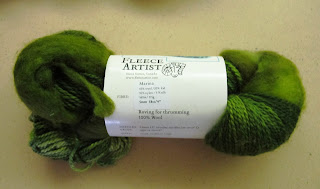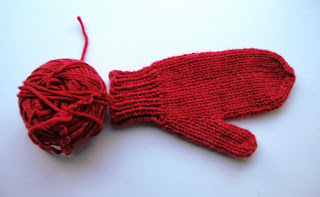
I was banging on about these so much recently, I though I might share the pattern.
They are worked top-down, so they're ideal for using up leftovers - and the thumb gusset is created by decreasing rather than increasing - I think it's a bit more elegant that way! If you are working from leftover yarn, divide it into two balls, and just work until you've run out of yarn.
A single mitt takes about 15gm-20gm of fingering weight yarn.
This is a slightly modified version of the pattern from the book, shorter in both hand and cuff for better use as layering mitts - and to help you use up leftovers!
If you've never made mitts before, this is a good place to start, as they skip many of the tricker bits of mitten-knitting. As long as you know how to knit in the round, you're good.
SIZES AND FINISHED MEASUREMENTS
Size XS (S, M, L, XL)
To Fit Teen/Women’s XS (Women’s S, Women’s M, Women’s L/Men’s S, Men’s L)
Hand Circumference 7(7.5, 8, 8.5, 9) inches
Full Length (adjustable) 6-7 inches
MATERIALS
Approximately 120 (130, 140, 160, 180) yds Fingering weight yarn.
1 set US 2.5/3mm needles for working in the round– DPNs, two circulars or a long circular as you prefer
Stitch markers
GAUGE
28 sts and 40 rounds over 4 inches/10 cm square in stockinette stitch in the round
Note: stitch gauge is very important, round gauge less so.
METHOD
Top
Cast on 42 (46, 50, 52, 56) sts. Distribute sts across needles as you prefer and join for working in the round, being careful not to twist. Note or mark beginning of round.
Ribbing round: (K1, p1) around.
Work ribbing as set for 1 inch.
Next round: Knit.
Work as set until piece measures desired length to thumb. I work mine so that they're 2 to 2.5 inches long so that they just cover my knuckles. Add an inch ro an inch and a half to cover more of your fingers.
Create thumbhole
Next round: Bind off 6 (6, 6, 6, 8) sts, k to end of round.
Following round: Using either the cable or backwards loop method, cast on 12 (12, 12, 14, 16sts, knit to end of round. 48 (52, 56, 60, 64) sts.
Note: You’ll probably find it easier to keep the new cast-on sts on the end-of-round needle as you work the first few rounds of the next section. If you do, place a marker before the cast on sts so you don’t lose track of the start of the round.
Knit 4 (2, 2, 2, 4) rounds. If you need to, rearrange sts at this point so that start of round is at the start of a needle, and place a second marker after the 12 (12, 12, 14, 16) cast on sts.
1st size only:
Decrease round: K1, SSK, k to 3 sts before marker, k2tog, k to end of round.
Knit 3 rounds.
Repeat the last 4 rounds 2 (-, -, -, -) more times, and work decrease round once more. 40 (-, -, -, -) sts.
2nd, 3rd, 4th and 5th sizes only:
Decrease round: K1, SSK, k to 3 sts before marker, k2tog, k to end of round.
Knit 5 rounds.
Repeat these last 6 rounds - (2, 2, 3, 3) more times and work Decrease round once more. - (44, 48, 50, 54) sts.
The thumb markers can be removed at this point.
Final decrease round: Knit, decreasing 6 (8, 10, 10, 10) sts evenly around. 34 (36, 38, 40, 44) sts. (See below for help with this.)
The final decrease round: Ultimately, it doesn’t really matter how you get to the final stitch count, but if you’re not sure how to do it, use these instructions.
1st size: (K5, k2tog, k4, k2tog, k5, k2tog) twice. 34 sts.
2nd size: (K4, k2tog, k3, k2tog) 4 times. 36 sts.
3rd size: (K3, k2tog) 8 times, (k2, k2tog) twice. 38 sts.
4th size: (K3, k2tog) 10 times. 40 sts.
5th size: (K3, k2tog, k4, k2tog) 4 times, (k3, k2tog) twice. 44 sts.
Cuff
Ribbing round: (K1, p1) around.
Work ribbing as set until cuff measures about 3 inches.
Note: This distance is the length of the cuff, worked down from the wrist. You can lengthen or shorten this as you wish. (Just remember, if you do make them longer, you might need more yarn!)
Bind off as follows:
K2, *insert tip of left needle into the fronts of these two sts (as if to ssk), and knit them together; k1. Rep from * until all sts are bound off. Cut yarn and pull through final st to secure.
Finishing
Block (by giving then a wash, no special treatment needed) and weave in ends.

















